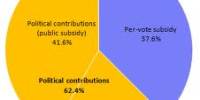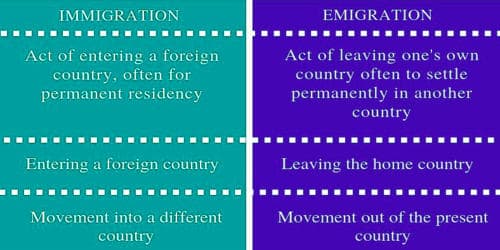Organization’s mission and vision:
Vision is of a just, enlightened, healthy and democratic world free from hunger, poverty, environmental degradation and all forms of exploitation.
Mission is to work with people whose lives are dominated by extreme poverty, illiteracy, disease and other disadvantages. With a holistic approach, we strive to bring about positive changes in the quality of life of people who are poor. We achieve our mission by:
- Working with the poor, especially women and children;
- Engaging in multifaceted development interventions;
- Striving to promote positive changes in quality of life;
- Working towards attaining socially, financially and environmentally sustainable programmes;
- Actively promoting human rights, human dignity and gender equity;
- Helping to shape national and global policies on poverty reduction and social progress;
- Fostering the development of human potential;
- Offering professional development opportunities to our staff;
- Encouraging commitment to the goals and values of the organization.
Nature of Business:
In Bangladesh, the poor have traditionally been denied access to the formal banking system, as they are unable to provide collateral for loans and typically deal in small amounts of money. This means that they have few opportunities to save, borrow and invest. Moneylenders in the informal credit markets charge very high interest rates which also restricts people’s access to credit. BRAC believe that making credit, which can be invested in productive activity, universally available is essential in reducing poverty.
BRAC launched their microfinance programme in 1974 to encourage the increase of income for the poor through the setting up and expansion of income generating activities and microenterprises. BRAC work to provide collateral-free financing to the poor, especially women, in both rural and urban areas, in a simple, efficient and affordable manner.
Their approach differs from that of other microfinance institutions – they utilize a credit-plus approach where loans are accompanied by various forms of assistance for the borrowers, such as skills-training, provision of higher quality inputs and technical assistance as well as marketing for finished goods.
They organize our members into village organizations (VO) of 30- 40 women. BRACs members are encouraged to use their credit facilities to start new enterprises or expand existing ones and as they increase their business, they progressively graduate to larger loans. Aside from microfinance, these VOs act as a gateway for BRACs members to their other interventions in health, education and social development.
BRAC offers two different microfinance products: microloans (group-based, exclusively for women) and microenterprise loans (individual loans for both men and women) under three different schemes which are Dabi, Unnoti, and Progoti.Group based small loans are particularly designed for the lower end poor to assist them in undertaking income generating activities. Microenterprise loans are available for small entrepreneurs to offer scope for expanding their businesses and capital base.
Today, BRAC is one of the largest global providers of financial services for the poor. As of December 2007, the programme was serving 7.37 million poor, landless and disadvantaged people, mostly women, through 260,785 village organizations. So far BRAC have disbursed BDT 270,738 million (USD 4,638 million) with a 99.5% recovery rate.
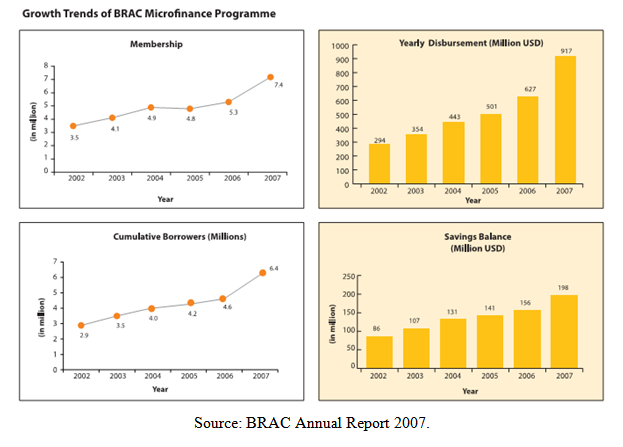
Activities of BRAC:
Economic Development Program:
BRAC’s Economic Development Programme has so far organizes nearly 5 million poor and landless people, mostly women into 160,197 Village Organizations (VO). These village organizations serve as forums where the poor can collectively address the principle structural impediments to their development, receive credit, open savings accounts and build on their social capital. BRAC microfinance programme, by offering credit to the poor, assisting and encouraging them to save. BRAC Microfinance Programme has so far disbursed Taka 165,794 million with a 99.49% recovery rate where no collateral is required. Members have saved up to Taka 9,159 million with BRAC.
Non formal primary education:
BRAC has started the programme in 1985. The programme started with 22 one-room schools and has grown to about 31,877 primary and 16,025 pre-primary schools by 2005. It fulfills BRAC’s goal of poverty reduction through access to education for those traditionally outside formal schooling. The BRAC schools teach the same competencies as the government schools. However they enroll and retain a higher proportion of hard-to-reach children, such as girls who make up 65% of the student body. Currently BRAC schools have enrolled about 14,471 children with disabilities, helping them overcome visual, hearing and speech impairments along with mental and physical challenges.
Essential health care program:
BRAC’s Essential Health Care Programme, aside from partnership programmes with government covering tuberculosis, malaria, immunization and sanitation, offers a road range of services to the poor including critical services in reproductive health care and disease control, mobilization of women and dissemination of information among the poor.
Support programs:
Support programmes at BRAC include the Training Division, research and Evaluation Division, Advocacy and Human Rights Division, Public Affairs and Communications, Administration and Special projects and Internal Audit and Monitoring. These programmes provide continuous support that is essential to the success and smooth functioning of BRAC’s core programmes.
BRAC has invested substantially in commercial enterprises, one of which is Aarong (chain of retail handicraft stores), that links poor rural producers with the expanding urban markets. Other enterprises include the BRAC Dairy and Food Project, which is the second largest liquid milk plant in Bangladesh, with an integrated system of milk procurement from rural dairy farmers to the production of quality dairy products. 6 Poultry Farms and 3 Feed Mills have been set up to meet the increasing demand for healthy chicks and quality feed in rural areas as well as to provide supply access to women trained in a variety of aspects of poultry rearing. Programme Support Enterprises, created form synergies between activities generated by microfinance beneficiaries and BRAC,s commercial ventures, consists of BRAC Printers, a cold storage, a tissue culture lab, 23 seed production and 2 processing centers, 12 fish and prawn hatcheries and a bull station to improve cattle breeds through artificial insemination.
Programme Support Enterprises
| Aarong Shops | 8 |
| Printing Press and Pack | 1 |
| Dairy and Food Projects | 1 |
| Poultry Farm and Hatcheries | 6 |
| Feed Mills | 3 |
| BRAC Nurseries | 17 |
| Prawn Hatcheries | 8 |
| Fish Hatcheries | 4 |
| Seed Production Centres | 23 |
| Seed Processing Centres | 2 |
| Bull Station | 1 |
| Broiler Processing Plant | 1 |
| Chilling Plants | 57 |
| Maize Production Centres | 3 |
| Iodized Salt Industries | 2 |
Source: Annual Report of BRAC
The intent of these commercial enterprises is to ensure economic sustainability for poor rural producers while creating new revenue streams for BRAC to fund its core development programmes.
Other BRAC initiatives:
BRACUniversity:
BRACUniversity was established as center of excellence that would marry BRAC’s extensive capacity development experience from the field level with academic knowledge imparted by a high quality faculty. It is expected that BRACUniversity, supported by BRAC’s existing resources, will be able to mould the next generation of visionary pro-poor leaders of Bangladesh to fill the current dearth.
BRAC Bank Ltd.
BRAC Bank is a venture by BRAC to bring good quality and reliable banking services, especially credit to small and medium enterprises (SME’s). The bank has disbursed over BDT 1,200 crore in loans to nearly 32,000 small and medium entrepreneurs. Since, its inception in 2001 BRAC Bank has become the faster growing bank in Bangladesh.
BRAC Abroad
BRAC Afghanistan
BRAC Afghanistan was conceived in May 2002 when BRAC realized that its development innovations and experiences in Bangladesh could be relevant in the alleviation of poverty and empowerment of the poor people of Afghanistan, many of whom were refugees returning to a war-torn land. Recognizing BRAC’s goodwill and impressed with its results in Bangladesh, the government of Afghanistan invited BRAC to begin mobilizing Afghan communities and providing development services in microfinance, health, education, income generation and small enterprise development. BRAC’s Afghanistan programme covers 19 out of 34 provinces in Afghanistan.
BRAC Sri Lanka
Following the Tsunami of 2004, BRAC began exploring possibilities of relief and rehabilitation operations in Sri Lanka to help those affected by the disaster rebuild their lives. As of 2005, BRAC Sri Lanka has been implementing its rehabilitation and livelihood activities in 8 of the most affected districts in Sri Lanka.
HRM Practice in BRAC:
Human resources policy and procedures are one of the important tools that plays significant and vital role in job satisfaction as well as motivation of the employees in an organization. This is used to perform the effective and unbiased in all the part of HRM for the employees.
From the early stages of its evolution, the Human Resource Division (HRD) of BRAC has been working with a goal to maximize job satisfaction, enhance transparency and ensure procedural justice for all employees. As one of the world’s largest Development Organizations, BRAC has a wide variety of multifaceted development programs. A large number of qualified, potential and committed staff is required to attain the organization’s goal and to operate these programs effectively. HRD has to provide extensive effort to ensure that the staff are appraised properly and are also provided with due services and entitlements in time. HRD tries to ensure an environment where the staff are nurtured and considered as absolute resources. To this end, HRD is committed to guarantee the assignment of right people in the right place at the right time, to flourish human potentials and provide a decent work environment.
This report has been focused on the Human Resources Policies and Procedure of BRAC. But it will be highly difficult to cover all the side of the BRAC HRPP within the short purview of this report. So, this report has been focused on job satisfaction, recruitment and selection process, employee motivation, performance appraisal, training program and overall HR policy of BRAC.
From the early stages of its evolution, the Human Resource Division (HRD) has been working with a goal to maximize job satisfaction, enhance transparency and ensure procedural justice for all employees. As one of the world’s largest Development Organizations, BRAC has a wide variety of multifaceted development programs. A large number of qualified, potential and committed staff is required to attain the organization’s goal and to operate these programs effectively. HR policy has to provide extensive effort to ensure that the staff are appraised properly and are also provided with due services and entitlements in time. BRAC tries to ensure an environment where the staff are nurtured and considered as absolute resources. To this end, HR is committed to guarantee the assignment of right people in the right place at the right time, to flourish human potentials and provide a decent work environment.

HR policy of BRAC:
BRAC is the largest NGO in the world. To demonstrate and reflect its goals and objective to social development into its HR policies BRAC has implemented its own human resource policies and procedures (HRPP). The HRPP has been revised in 1st October 2005. The HRPP includes all possible policies to run its day to day activities and it has been segregated into seven chapters. They are named as:
- Chapter One: Conditions of Employment
- Chapter Two: Service benefits
- Chapter Three: Classification of leave and regulations
- Chapter Four: Disciplinary rules and regulations
- Chapter Five: Job separation
- Chapter Six: Service related files and others
- Chapter Seven: Annexure
Important HR Function:
- Policy, Progress & Communications ( PPC )
- HRPP Monitoring
Compose Annual Plan of HRD by compiling the section-wise annual plan.
Prepare a HR Policy for the Service and Project Staff of BRAC
Network with other organizations in order to share best practices of HR in the field of Performance Appraisal, Salary & Fringe Benefits.
Formulate working manual (Operational guideline) for every units of HR.
Conduct census survey to determine the total number of staff working in BRAC by considering sex, program/ department, working area of spouse.
Prepare job description on the basis of level or designation.
Staff satisfaction survey on HR services.
Revisit Designation to standardize for different levels of staff.
- Networking
Half day discussion forum within different programs
Communication
Prepare annual plan for HRD
Arrange internal monthly meeting & prepare minutes.
Coordinates the overall activities that involve whole HR.
- Policy Formulation & Dissemination
Revisit Human Resource Policy and Procedure (HRPP)
Merge existing two policies (HRPP & Policy of Service Staff)
Prepare circular regarding policy
Update the existing formats and prepare new formats
HRPP orientation for (HR staffs – HO & FO, different program of HO staff & Aarong staff)
Half day orientation on policy entitlement for all BRAC staff
HSP seminar for Sr. Managements
HR performance survey
- Compliance of Law
Revisit the existing HRPP by considering revised Labor Law.
Develop compliance Monitoring report
Staff Development
Internship management
Arrange new staff orientation of HO
Arrange HR related training
Communication and relation building within and outside of the organization
Prepare annual report of HRD
Prepare quarterly HR Bulletin
Study circle
Train the Human Resources officers of BRAC (THROB)
TOT on HSP and gender for HO staff
Follow up Individual Operational Plan (IOP)
Collect training materials from the staffs who attend training
Exposure visit (Exchange staff from HO to FO, FO to HO & BRAC to different organization – within or outside the country)
Manage HR related activities of Internal & International Training, Travel and Higher Study
Prepare summary of trainings received by HRD Staff.
Send HR related articles, summary of training, important articles of HSP to ‘SHETU’
Analysis and Findings of HR Policy for HR Department:
With human nature being what it is, employees will test limits and act “creatively” in workplace situations, so we need a strategy for developing, communicating and enforcing a set of policies and practices that reflect our standards of acceptable behavior.
But a successful policies and practices strategy does more than draw boundaries; it also recognizes and addresses people’s needs.
There are many different types of people, and not surprisingly, they react differently to the need for policies and practices based on those differences. For example, some people prefer there be a written policy for everything, while others favor having no policies at all and would leave everything open to interpretation as situations arise. Neither of these extremes contributes to a work environment that’s conducive to high productivity levels. The answer is found in between, with the right number and types of policies and practices that are focused on a primary goal–improving individual performance in the workplace.
When someone gets to the heart of the matter, performance improvement is really about the process of setting expectations and meeting them. The focus in business is not just about meeting specific goals, but also about how you achieve them. And the “how” affects the liabilities create in the process.
In my analysis I found different respond regarding the HR policy but some are positive and some are negative. BRAC has a written personnel handbook which regularly reviewed and update they also follow nondiscriminatory hiring and BRAC also provides a copy of this policy to every member of board, over 85% respondent fill positive thing about it. On other hand they give negative respond for some particular area which may be BRAC does not follow. In the research I saw BRAC does not have job description including qualification, duties, reporting relationship and key indicators because almost 65% respondents disagree with it. But every company should have the written job description, duties and reporting relationship. BRAC is established and big organization they must have those thing in written.
Again BRAC has their problem in strategic planning of future HR because they cannot fill timely the vacant position which create problem to on going program. Because some time some task fail to implement only for shortage of skill HR. Over 80% respondent say that it is the problem that BRAC does not filling the vacant positions in time. Another thing is very important is documenting the staff information about their job, 65% of my respondent say give respond as neutral that’s mean they don’t know about it or they thing it is not important for the organization but documenting the staff information about their job is very important its help the organization to locate the specific HR in any particular time or in task.
Analysis and Findings of Recruitment and Selection Process for HR Department:
As the recruitment process is the integral part of the HRM department and the company depends on the position of the recruited position so they need to make sure about the various recruitment philosophy which should match with the organizational and the cultural goals the company has to recruit those kinds of people who will adjust himself with the environment of the company. That’s why there is a strong relationship with the organizational goals and objectives with the various recruitment processes.
If the company hires the employees who are not efficient enough and they will not bring anything productive to the organization. Rather than that they will be the source of extra burden to the assigned position and the related working environment, so the company will have to recruit the employees again after firing that persona and go through a newly oriented recruitment process to recruit for that position which is the wastage of time, energy and money of the company. So the recruitment should achieve the organizational and also the departmental goals and objectives and in order to get it efficiently we have to hire skillful, experienced and trained employees to make sure about the proper recruitment process to go through the strict assessment and get the best applicant in the job fort the assigned position.
In my research in this part I found that recruitment and selection process for HR department is very much standard except some point. Nothing is perfect in this world. In this part I analyze about communication about the recruitment with HRD, mentions the job specifications while recruiting employees, formalized job description for position, examiner are fair to all candidates, recruitment and selection processes are easy, systematic recruitment process, probation period, high turnover, equal opportunity, person job fit strategy, orientation program, communicated career advancement opportunity etc. in most of the part I found satisfactory feedback to my respondent, most of the part have above 40% positive respond. From that point I can summarize that their recruitment and selection process for HR department is well defined.
The company and the Human resource Department need to make all the necessary arrangements to make sure that the right people are in the right place and to be assigned for the right responsibilities or job. So the HRM should take all the initiatives to make sure that the employees who are recruited are really productive and skillful enough to make all the important decisions in the organization. So the relationship is very important and helpful for the both the parties.
But some case like when a candidate dropout at the final selection round they do not get any feedback regarding their weakness and future suggestions. Every respondent of my research say BRAC do not give this type thing.
Internal Office management
Develop feedback system
Social Events (Picnic, Day celebration, Birthday celebration etc.)
- Main Responsibility of PMS:
1. Promotion, Increment & Special Allowance
2. Recommended for Training
3. Yearly Assessment
4. Upgrade Quarterly Staff Position
5. Re-Designation
6. Certificate Ensure
7. Planning Revisit PMS
8. Identify Managerial Staff & Provide Training
9. Organize Orientation on PMS
10. Identify those staff who did not get recommendation for promotion from last 5 years.
- Separation Management Unit
Separation Management is one of the core units of Human Resources Division of BRAC. Its main task is to ensure the final payment of BRAC Staff, who resign, and are terminated, retired, redundant and dismissed.
Job Separation
Resignation
Retirement & Voluntary Retirementv Termination
Redundancy
Dismissal
- Recruitment Unit
Requisition received from program
Making plan through Critical Path Method (CPM)
Preparation of advertisement & publication
CV received from the applicants.
Screening
Putting roll no on the sorted CVs.
Examination Planning.
Determining date and type of examination
Selection of venues for written test & viva voce
Seat planning according to capacity of venue for written test & viva voce.
Interview card preparation and mailing
Find out the requirements of invigilators and viva board members and send letters to concerned programs and Preparing invigilators & viva board members list.
Preparing pre service training schedule
Calculating anticipated number of primarily selected candidates for pre service training.
Distributing them TARC/ batch wise. (Each batch may contain 30-35 candidates)
Communicate with BTD about pre service training of expected selected candidates to make necessary arrangements.
Venue-wise confirmation of vehicles.
Preparing instruction sheet for written test, viva voce and pre service.
Preparation Question and Answer script.
Prepare candidates list.
Deployment preparation for the primarily selected candidates.
Preparation of final deployment.
- Confirmation Unit
Follow up for Confirmation Assessment (Head office & FHRO)
Assessment received from Programs & FHRO
Assessment check (Manually)
Assessment checked by computer (Find the present status of staff)
Assessment sorted according to PIN
Assessment Entry (HR Module)
Prepare a requisition list of required files for HRIS unit
File out from the cabinet
Prepare the Confirmation letter (3 copies-person copy, A/C copy & File copy)
Process the letter (Attached with Provident Fund & Nominee Form)
Placement the letter to Director HR/Senior Manager HRD for signature
Confirmation entry with Salary & Verify
Confirmation letter disburse entry according to FHRO
Prepare a list of return file for HRIS unit
File serial on the basis of PIN
Put back the file to cabinet
Gender Justice and Diversity:
Gender Justice and Diversity Unit (GJ&D) is one of the unique and effective continuous learning action initiatives of BRAC to improve gender relation and create gender sensitive working environment within BRAC. The unit started to work in a new shape under Human resource Department of BRAC from July, 2005. The unit was designed to sensitize and strengthen staff capacity and act as a caterer to the informational needs and on going dialogue to implement the gender policy of BRAC.
The G J & D Unit helps to build awareness within the organization and in the society about women’s productive and reproductive roles, to recognize the importance of women’s empowerment and to help build a platform to work towards a violence and discrimination free, just society for women.
The programs and projects of the unit is also extended to build alliances across differences, so that we can work together to eradicate all form of discrimination. As a part of BRAC, the unit works with several other programs such as BRAC Development Program, BRAC Education Program, BRAC Health Program, Social Development, Human Rights and Advocacy and so on. The recognition of the unit about the necessity of a gender orientation in other programs, thus other groups of the community of BRAC makes it a diversified unit providing assistance and alliance to different groups of the community.
Following is a list of the activities the G J & D Unit is involved in:
- Gender Quality Action Learning (GQAL) for Village Organization (VO) Members
- GenderResourceCenter
- Gender Awareness and Analysis Course (GAAC)
- Gender Policy
- Gender Training (Local Government)
- Day Celebration
- Gender Equality and Diversity Team (GEDT)
- Women’s Forum
- Networking and Alliance
- Day care Center DOLNA
- CapacityBuilding Initiatives for HRD
Recruitment and Selection:
BRAC is the biggest non-government organization in our country. The main reason for their success is for their motivation of the entrepreneurs, their enthusiasm, and of course the relentless effort of all the human resources of BRAC who are directly or indirectly related to this organization.
BRAC has been providing biggest employment in Bangladesh. With 37,410 Full time staff, 53230 BEP Teachers, 2,439 project staff and 789 service staff, BRAC manages and develops a huge pool of diverse human resources throughout the country. Among the total BRAC workforce 2.09% staff is from the head office, and the rest 97.31% captures the field office. Though staff ratio in Head office is relatively low, but it is also the hub of central decisions and core activities. It is because of the major support from the head offices that the development activities are smoothly run in field operations as well. BRAC HR enforces procedural justice to intensify transparency that nurtures potential, promotes innovation, change and quality. BRAC brought about a large change to modernize the HR division by decentralization and enhancement.
I choose a part of my project Recruitment and Selection system in BRAC. I believe it is the primary activity of the human resource operations and in fact a major element affecting the long term outcomes of an organization. I have focused my research into the head office, although majority of the workforce of BRAC are field staffs, but it is from the head office where the main program coordination and planning activities take place. So recruiting the right person for head office is a major challenge. So an analysis on this process will bring out the most important factors that must be considered in an effective staffing process.
Recruitment system in BRAC:
BRAC recruitment unit are following some procedure and they are practicing regularly for their recruitment process. Process are describing below sequentially:
Requisition received from program
Making plan through Critical Path Method (CPM)
Preparation of advertisement & publication
CV received from the applicants.
Screening
Putting roll no on the sorted CVs.
Examination Planning.
Determining date and type of examination
Selection of venues for written test & viva voce
Seat planning according to capacity of venue for written test & viva voce.
Interview card preparation and mailing
Find out the requirements of invigilators and viva board members and send letters to concerned programs and Preparing invigilators & viva board members list.
Preparing pre service training schedule
Calculating anticipated number of primarily selected candidates for pre service training.
Distributing them TARC/ batch wise. (Each batch may contain 30-35 candidates)
Communicate with BTD about pre service training of expected selected candidates to make necessary arrangements.
Venue-wise confirmation of vehicles.
Preparing instruction sheet for written test, viva voce and pre service.
Preparation Question and Answer script.
Prepare candidates list.
Deployment preparation for the primarily selected candidates.
Preparation of final deployment.
Introduction to the Report:
Rationale of the Study:
With the increase in the size and complexity of business organizations, man has become the most important factor in business. Business needs people as owners, employees, and consumers. Organizations need people to make them operate. Business may be operated differently and the objectives of business may differ, but the universal element in all business activities is people. An organization is nothing without human resources. Any human organization- a factory, a hospital, or and association- consists of people working together. According to economists, the factors of production are land, labor, capital and entrepreneurship. Of all the resources, the most important one is human resource, because human beings play a dual role- as resource, as well as a motive force for all other resources by manipulating them, by way of developing, utilizing, commanding and controlling. It is the most important of all other resources. This is because manpower is that resource through which management wants to control and direct all other resources like machines, materials, money and others. An organization is nothing without people.
BRAC has a wide variety of multifaceted development programs. A large number of qualified, potential and committed staff is required to attain the organization’s goal and to operate these programs effectively. HRD has to provide extensive effort to ensure that the staff are appraised properly and are also provided with due services and entitlements in time. HRD tries to ensure an environment where the staff are nurtured and considered as absolute resources. To this end, HRD is committed to guarantee the assignment of right people in the right place at the right time, to flourish human potentials and provide a decent work environment.
And as business administration student I got chance to implement my theoretical knowledge in the practical world, which has support me lot to know so many things about my study’s specific area.
Statement of the Problems:
Broad Statement: To analyze overall BRAC HR policy and procedure.
Specific components: To determine whether –
- Is the recruitment and selection process of HR department is up to the mark.
- The employee job satisfaction level and its outcome.
- How BRAC motivate their employee and loyalty level for the organization.
- Does the performance appraisal system match with job satisfaction and motivation of the employee.
Scope and Delimitation of the Study:
The study intends to investigate the HR policy and procedure of BRAC which effects of skills on their employee. For this study, primary research and secondary research will be used. Primary research will be conducted using anonymous questionnaires that will fill by the employee by their own. The questionnaires will be used to collect quantitative data.
The data will be analyzed and compiled for the correlation of the hypothesis. The data will then be presented by means of graphical representations and illustration and the difference would be highlighted. A negative correlation between the variables would suggest that the hypothesis is null, that is.
Objectives of the Report:
Human resources are the ultimate element of any organization that implement the task and achieve the organization goal. But for this HR every company has their own policy and rules for developing their human resources. BRAC is working for the development of human beings in terms of improving their earning capacity and ultimately the living standard. Since the goal is mostly dependent on the efficiency of the employees, management should identify the dissatisfaction of the said group and also should take measures to improve the situation.
General objective:
To assess the HR Policy system implementation for all-level employees of BRAC.
Specific objective:
- To find out the level of satisfaction of employee in their position;
- Review the recruitment and selection process and to evaluate the effectiveness of the same;
- To find out the relationship between employee motivation and performance of the employee in BRAC.
- Evaluate the effectiveness of the performance appraisal systems used by BRAC;
- Evaluate the effectiveness of the training program.
- Methodology of the Study:Sampling Design:
I choose quota sampling of non-probability sampling techniques to collect data. Quota sampling viewed as two stage restricted judgmental sampling. In The first stage I develop two control categories or quotas i.e. Male and Female of population elements. In the second stage, sample elements are selected based on designation i.e. DGM, GM, Sr. Executive, Executive, Officer etc. I take a sample size of 15 to conduct my survey.
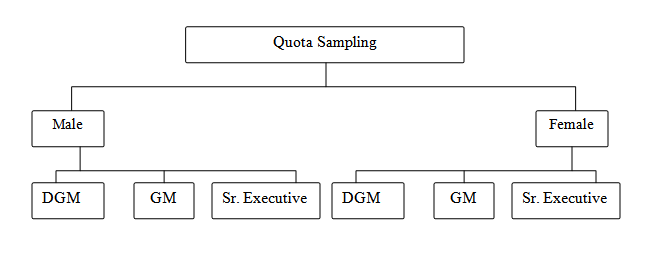
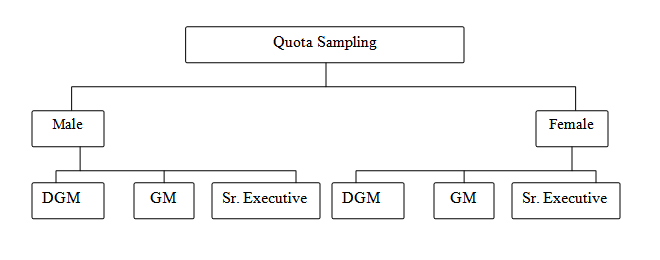
- Methods of collecting data:I collect data from two sources Primary sources and Secondary sources. In primary sources I basically do the interview, give questionnaire, observe the employees etc and from that I gathered my unique data. And before that I collect data from secondary sources like journal, BRAC Annual report, publications and brochures, previous research etc. Basically secondary research help to understand what is happening and also help to understand the theoretical part of the research.
Scaling techniques:
Since Likert scale is a worldwide acceptable scale, I used it. It is basically non-forced scaling method. I avoid complexity, leading & loaded question, ambiguity, double-barreled item, making assumptions and burdensome questions. I tried to make the questionnaire as simple as possible. I also used positive statements so that I get correct answer from my respondents. To determine the degree of respondents’ ascent regarding each statement five numbers are respectively assigned form 1 to 5, are shown below:
Strongly disagree = 1 Disagree = 2 Neutral = 3 Agree = 4 Strongly agree = 5
I used this things so that respondent can understand easily and identify the answer. I gave a blank table with each question for easily pointing out the result.
Software used:
Using structured questionnaires I collected primary data from different respondents. I used 5 point Likert scale which encompasses strongly disagree = 1, Disagree = 2, Neutral = 3, Agree = 4, strongly agree = 5. I used SPSS 10.0 to analyze my primary data which were obtained from 15 respondents. To analyze data from respondents I did different analysis for my research.
Analysis, Findings and Interpretation of the Data:
As my topic is “An Analysis of Human Resources Policies and Procedure of BRAC” I divide my research into four segments, i.e. Employees job satisfaction, Recruitment and selection process for HR department, Employee motivation and HR Policy (HR Department). This four parts is very important in HR.
Analysis and Findings of Employees Job Satisfaction:
Job satisfaction is in regard to one’s feelings or state-of-mind regarding the nature of their work. Job satisfaction can be influenced by a variety of factors, eg, the quality of one’s relationship with their supervisor, the quality of the physical environment in which they work, degree of fulfillment in their work, role in decision making process, individual career prospect, job security, welfare activities etc. In my research I asked some question to my respondent which give me a probable picture of their satisfaction level in different area. From my research most of the respondent are satisfied with their present salary, fringe benefits, retirement benefit, working environment, office timing, weekly holiday, canteen and other facilities, co-operation from colleagues and supervisors etc. because in every part above 40% of my respondent agree with the statement. On other hand some important thing comes out for the research most of the respondent say that they can participate in decision making at their workplace, from this point I can say BRAC practice participative management in their decision making process which help them to achieve the goal of their organization. They also satisfied with their performance appraisal, reward and recognition, present position, welfare activities and organizational recreational facilities.
But in some cases I found some problem like; when the question come about opportunity for promotion then most of above 55% is satisfied but over 40% also say they are neutral about this matter. From my research view I can say most of them are satisfied but in rational then one question come that why those 40% are neutral may be there is some problem. If BRAC does not concentrate on this 40% may be those people satisfaction level goes in negative. Again when question come about the career prospect, disciplinary procedure, opportunity to express grievances then above 50% say they are neutral and some agree with those statement and some disagree. But in here I think there is lack of communication among employee and management about their career prospect.
- Another one thing is the research shows that above 70% respondent say that they are not satisfied with their job security. But job security is very important part for job satisfaction and it direct related with the productivity because if the employee fill his or her job is not very much secured he or she can not work with his full effort.
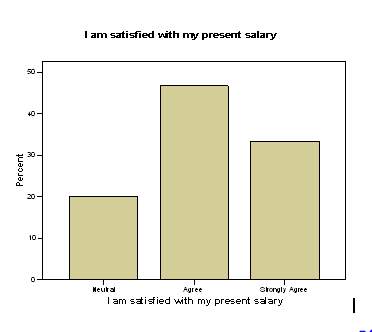
- Analysis and Findings Employee Motivation:There is an old saying you can take a horse to the water but you cannot force it to drink; it will drink only if it’s thirsty – so with people. They will do what they want to do or otherwise motivated to do. Whether it is to excel on the workshop floor or in the ‘ivory tower’ they must be motivated or driven to it, either by themselves or through external stimulus.
Motivation is the inner force that drives employee behavior. The intensity of one’s inner force to do a task or accomplish a goal describes the level of motivation. Two people may both say and believe they want to be excellent employees. The intensity of their desire to be excellent measures their motivation. Employers pay more attention to what employees do than what they say or believe. Motivation is the force that causes employees to deliver on what they say.
In my research BRAC has take some initiative about their employee motivation because in analysis I found in some criteria employee respond very well specially when the question come about primary aim of the organization is well communicated to the employee, performance appraisal, empowerment within organization, employee and organizational goal are aligned, employee safety and security, employee involvement in OD process, organizational image, pattern of employee motivation, in all this part over 90% respondent say they are agree or satisfy.
But in somcase they disagree which represent good thing for BRAC. BRAC has change their some policy and procedure in different stage but almost 100% say it is not affect in their motivation process. Which is very good for the organization because when any thing change in the organization, the employee fill bad or scared?
Most employees prefer to be motivated. Why would an employee choose the frustration of not being motivated? Motivating jobs and work environments win praise from employees. Of course, what one person finds motivating another may find boring, frustrating and debilitating. And employees sometimes bring a lot of baggage to the workplace from their childhood experiences, previous employment and failures to find their motivating niches in life.




